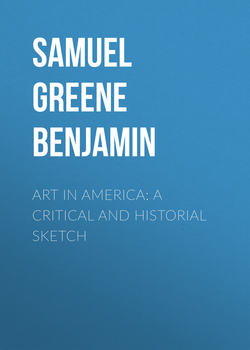Art in America: A Critical and Historial Sketch

Реклама. ООО «ЛитРес», ИНН: 7719571260.
Оглавление
Samuel Greene Wheeler (S.G.W.) Benjamin. Art in America: A Critical and Historial Sketch
PREFACE
I. EARLY AMERICAN ART
II. AMERICAN PAINTERS. 1828-1878
III. AMERICAN PAINTERS. 1828-1878
IV. AMERICAN PAINTERS. 1828-1878
V. SCULPTURE IN AMERICA
VI. PRESENT TENDENCIES OF AMERICAN ART
Отрывок из книги
THE art of a nation is the result of centuries of growth; its crowning excellence does not come except when maturity and repose offer the occasion for its development. But while, therefore, it is yet too soon to look for a great school of art in America, the time has perhaps arrived to note some of the preliminary phases of the art which, we have reason to hope, is to dawn upon the country before long.
As the heirs of all the ages, we had a right to expect that our intellectual activity would demand art expression; while the first efforts would naturally be imitative rather than original. The individuality which finds vent in the utterance of truth under new conditions is not fully reached until youth gives place to the vigorous self-assertion of a manhood conscious of its resources and power. Such we find to have been the case in the rise of the fine arts in this country, which up to this time have been rather an echo of the art of the lands from which our ancestors came, than distinctively original. Our art has been the result of affectionate remembrance of foreign achievement more than of independent observation of nature; and while the number of artists has been sufficiently large, very few of them stand forth as representatives or types of novel methods and ideas; and those few, coming before their time, have met with little response in the community, and their influence has been generally local and moderate, leading to the founding of nothing like a school except in one or two isolated cases. But many of them, especially in the first period of our art, have shared the strong, active character of their time; and, like the heroes of the Revolution, presented sturdy traits of character. And thus, while the society in which they moved was not sufficiently advanced to appreciate the quality of their art, they were yet able to stamp their names indelibly upon the pages of our history. But within the last few years the popular interest in art has grown so rapidly in the country – as indicated by the establishment of numerous art schools and academies, art galleries, and publications treating exclusively of art subjects, together with many other significant proofs of concern in the subject – that it seems safe to assume that the first preparatory period of American art, so brilliant in many respects, is about closing, and that we are now on the threshold of another, although it is only scarcely three centuries since the first English colonists landed on our shores. The first professional artist of whom there seems to be any record in our colonial history was possessor of a title that does not often fall to the lot of the artist: he was a deacon. This fact indicates that Deacon Shem Drowne, of Boston town, was not only a cunning artificer in metals and wood-carving, as the old chronicles speak of him, but also a man addicted to none of the small vices that are traditionally connected with the artistic career; for people were very proper in that vicinage in those days of austere virtue and primness, and deacons were esteemed the very salt of the earth.
.....
In the same year with Trumbull was born the greatest colorist and portrait-painter we have seen on this side of the Atlantic, Gilbert Stuart. The town of Narragansett, in the little State of Rhode Island, was the birth-place of this painter, who came of Scotch and Welsh descent, an alliance of blood whose individual traits were well illustrated in the life and character of the painter.
Fortune was becoming a little kinder to our artists. Stuart's dawning genius was directed at Newport by Cosmo Alexander, a Scotch portrait-painter of some merit, who took his pupil to Scotland and placed him in charge of Sir George Chambers. After various vicissitudes, comprising, as with so many of our early painters, an art apprenticeship in the studio of West, the young American artist settled for awhile abroad, and acquired such repute that he rivalled Sir Joshua Reynolds in the popular esteem: his brush was in demand by the first in the land; and the unfortunate Louis XVI. was included among his sitters. After this, in 1793, Stuart returned to America, painted the portraits of the leading citizens in our chief cities, and finally settled in Boston. The most important works he executed in this country were his well-known portraits of Washington, including the famous full-length painting, which represents the great man, not in the prime of his active days, as represented by Peale and Trumbull, but when, crowned with glory and honor in the majesty of a serene old age, he was approaching the sunset of life.
.....